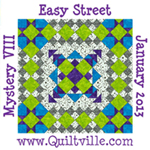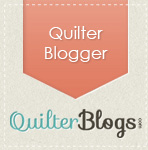Beacon Lights
page 44
Judy Hopkins 501 Rotary-Cut Quilt Blocks

One thing I should not do is watch a good movie when I am sewing these block, because I didn't stop to take pictures.....so I went to my comp. and drew up this block in EQ7 and printed it out so I could show you how I sewed it together.


The second block is:
Sugar Bowl
page 26
Around the Block with Judy Hopkins
page 26
Around the Block with Judy Hopkins



Now for a fun new way....I drew a 13 1/2 inch square on a sheet of tissue paper and drew a cross line through the center. I know it's hard to see, but it's tissue paper and I wanted to use a pencil for the lines.

I am going to be using up my scraps of fabric I have, remember those pieces I cut wrong or had extra or just some 2 1/2 inch strips. Now you are going to do some simple strip pieces and cover one of the triangles. This is starting with 2 pieces of fabric rights sides together and sew, then add another piece. Keep checking to make sure that after you flip the fabric over it will cover the line for the triangle. You don't need to sew pass the line very far, just about 7 or 8 stitches. Sewing 1/4 inch seams. Please press as you go..it will look nicer and lay better. I also tighten up my stitches by 1 or 2 marks (I put my machine on 2.5 for stitch length).

After you have the first triangle done, change the direction you are sewing and sew the next triangle differently.

Working with the 3rd & 4th triangles, I usual sew them together. This is where I use up the smaller pieces of fabric and sew them together until I get a strip. I general use this strip as my 2 -3- or 4 row.
This is one of my strips

Here you can see how I finished that section...

This is one more I did...

I don't like cutting them up until I plan on using them, but I wanted you to see what you get. I plan on using these as my side triangles and corner triangles when I put the quilt together on point. Depending on how you handle your fabric, you mite want to stitch around the out side of the triangles about 1/8 inch from the edge. Remember that the tissue paper will tear away easy and you will be working with bias edges. (That means it will stretch easily.) If you do stitch, do it before you tear the tissue paper away and try to do it when you are ready to use the triangles.
 You can also do this and cut out pieces for your quilt blocks you are sewing. It adds a lot of insterest and makes your quilt block look like you worked really hard to do the pieces.
You can also do this and cut out pieces for your quilt blocks you are sewing. It adds a lot of insterest and makes your quilt block look like you worked really hard to do the pieces. I wanted to spend a minute on rules and tapes. They are many, many kinds and types to choose from. Find ones you like. Look at the guide lines and color, do they have different sizes and shapes? Can you see them, how does it look on top of fabric. My favorite plastic rulers are the Omnigrid and with the tapes try to get one from a good quilt shop. Mine are Fiber-Glass. But the most important thing is, when you start to use one brand of ruler....stay with it. Not all rules are the same and sometimes your blocks will not be the same size after you sew them together. I do use tapes when I sew the borders on, but there again I only use one of my tapes and not two of them, even if they are the same brand, and I only use them to measure the border and then the fabric for the border.
I wanted to spend a minute on rules and tapes. They are many, many kinds and types to choose from. Find ones you like. Look at the guide lines and color, do they have different sizes and shapes? Can you see them, how does it look on top of fabric. My favorite plastic rulers are the Omnigrid and with the tapes try to get one from a good quilt shop. Mine are Fiber-Glass. But the most important thing is, when you start to use one brand of ruler....stay with it. Not all rules are the same and sometimes your blocks will not be the same size after you sew them together. I do use tapes when I sew the borders on, but there again I only use one of my tapes and not two of them, even if they are the same brand, and I only use them to measure the border and then the fabric for the border.
OK, now lets talk about the Corner Triangles and the Side Triangles. These are used to piece together you blocks on point. Here they are colored green. You are doing this so that the grain or straight grain of fabric will be on the outside of the quilt. It will make sewing the borders on nicer.

The Corner Triangles are made from a square cut in half diagonally in one direction, giving you 2 triangles. You need to calculate the size of square needed by dividing the finished block size by 1.414 and adding .875" (7/8") for the seam allowances and then round this up to the nearest 1/8".

The Side Triangles are made from a square cut corner to corner, twice, giving you 4 triangles. You need to calculate this size of square by Multiplying the finished block size by 1.414 and adding 1.25" (1 1/4") for the seam allowances and round this up to the nearest 1/8". I will add about 1/2 to 1 inches more to the beginning square and then trim them down later. It's better to start alittle bit bigger than to sew them again because they are to small.





























































No comments:
Post a Comment